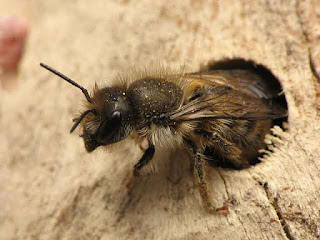"There ain't no words for the beauty, the splendor, the wonder."
 |
| Photo by Dominicus Johannes Bergsma/Wikimedia Commons. |
Gardening is not just about growing pretty flowers and delicious foods. It’s also about enjoying nature, and some of the most fun to watch are the little flying creatures that hover and dart about. There are, of course, the butterflies, honeybees and bumblebees. But most interesting – to me, anyway – are the tiny little bees. Some are brown. Some black. Some iridescent. These are the native bees, sometimes called sweat bees, cutter bees, or mason bees. They are essential to good pollination. It feels good to provide a place where they like to hang around.
It’s well-known that flowers provide bees with food. That’s they real reason they’re there. Their acts of pollination are actually happy accidents that they perform while brushing against pollen in their quests.
But apart from planting native wildflowers, we can also attract them by providing homes. Many of us think of bee hives when we think of homes for bees...or hair.
I let it fly in the breeze
And get caught in the trees
Give a home for the fleas in my hair
A home for fleas
A hive for the buzzin' bees
A nest for birds
There ain't no words
For the beauty, the splendor, the wonder
Of my...
Hair, hair, hair, hair…
-The Cowsills
You know where I'm coming from. But that’s not it. Those little bees nest in surprising little hideaways like tunnels excavated by beetles, crevices, broken branches, holes in the ground, rotten logs, abandoned lumber, old reeds and hollowed-out stems. Some of which we can provide with ease.
 |
| Photo by Beatriz Moisset/Wikipedia Commons |
Here are some simple ideas:
- Find old logs, and drill deep, horizontal holes of various diameters – between 1/16 inch and 1/2 inch – in the ends.
- You can do the same with dead trees, but don’t drill into living ones.
- Gather hollow reeds about 6” to 8” long. Miscanthus spp., Arundo donax and pampas grasses are good examples. Bundle them together, and tie with twine. Place them horizontally around the garden in clay pots, or hang them under the eaves of your tool shed to keep them dry.
- If you’re ambitious, construct little structures resembling bird houses with the fronts removed, and stuff them with the reeds.
- You can do the same with lengths of old Rubus canes, Sambucus stems or Chinaberry (Melia azedarach) sticks.
- Bamboo canes will serve well, and are longer lasting, but the segments might need to be reamed out with a drill to make the nesting spaces deep enough.
- If you intend to use old lumber, avoid pressure-treated woods which could be toxic to bees.
These are things that you can do with your kids, teaching them something about nature and to be kind to creatures.
To be sure, there are purists out there who would say, “Oh NO! That’s not the way to do it! What a terrible idea.” But, frankly, I’ve never known bees to follow all the rules. Some drill holes in my house, stored lumber, and even try to nest in my electrical outlets. I say, “Don’t stress out about it.” Have fun. Do good.
Return to GoGardenNow.com.





No comments:
Post a Comment